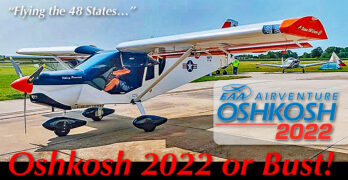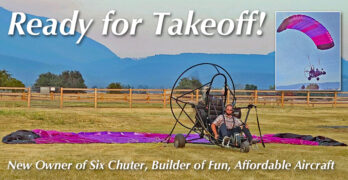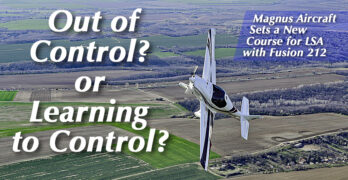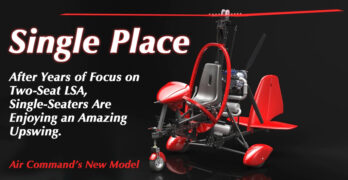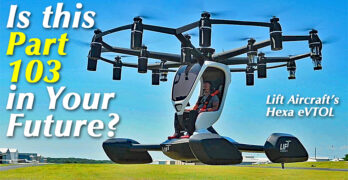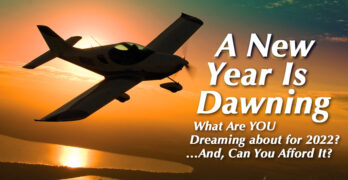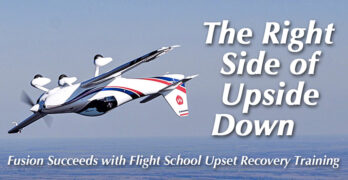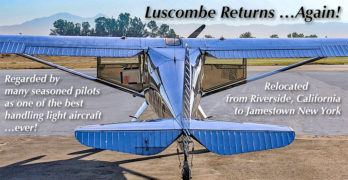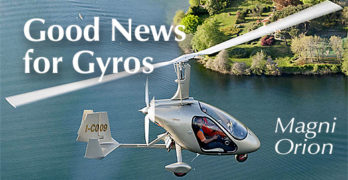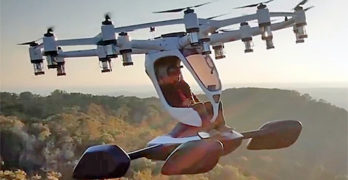“Time to spare? Go by air!” is a familiar humor line, speaking to weather uncertainties, mechanical delays, or relaxed cruise speeds that can slow or stall a cross-country flight in our fun, recreational aircraft.
One man created his own special way to log some flight hours getting to Oshkosh. Evidently this adventurous pilot never heard another popular line: “The shortest distance between two points is a straight line.” (Don’t anyone challenge me with Great Circle routes; this is about a long flight but not a globe-spanning one.)
While pilots around the nation are in various stages of preparation for the flight to EAA’s big summer celebration of flight, our aerial explorer is already en route. He’s about halfway as this is posted.
Ambitious Journey
I’ve had the pleasure to fly into Oshkosh a number of times. I’ve also several times flown with pilots making their first entry. Ask anyone who’s done it; joining the arrival pattern to Oshkosh on the busy days right before it opens is an experience no one forgets.
Search Results for : Texas aircraft
Not finding exactly what you expected? Try our advanced search option.
Select a manufacturer to go straight to all our content about that manufacturer.
Select an aircraft model to go straight to all our content about that model.
Affordable Aviation Includes Powered Parachutes — Welcome New Owner of Six Chuter!
Considering the company has always been a western U.S. manufacturer, a name that sounds like “six shooter” conjures a cowboy image, horse-riding westerners packing a pistol on their hip. Actually, it’s just a fun name.
Six Chuter’s aircraft are enjoyable enough and the company careful enough about how it treated its prospects and customers that they managed to sell more than 2,100 aircraft since forming three decades back. Over many years of examining hundreds of companies, I am aware only a very small number of airplane producers that have built more than 2,000 aircraft. Six Chuter is clearly a company prepared to stick around for a while. Here’s a very brief look back at its history.
Six Chuter is one of the longest operating powered parachute companies in business today, founded in 1991 by Dan Bailey in Yakima, Washington. Dan sold the company when he felt it was time, in 2010, to “pass the baton” to prior Six Chuter dealers Doug Maas and Tom Connelly.
First “Official” Aerobatic LSA Trainer: Magnus Fusion and ULPower Announcements
“Now, wait a minute,” I hear some object! “You can’t do aerobatics in a Light-Sport Aircraft. It’s not allowed.” Are you sure about that?
True, most LSA are not recommended for aerobatic flying or training. However, one of the main reasons for that is that Rotax does not want their LSA 9-series engines used for aerobatics. If the engine manufacturer does not permit that, we’re done talking. It cannot be used that way. The airframe maker can also stipulate no such operations.
However, neither FAA regulations nor ASTM standards expressly prohibit aerobatics. We’ve already seen one entry that is capable of aerobatics — the FK-12 Comet biplane — but when that model uses a Rotax powerplant, going upside down on purpose is not permitted.
Has Magnus got a valid reason for pursuing aerobatics? Are they trying to invite owners to fly this way? A better rationale: With a capable aircraft, a qualified instructor can offer what some call “Upset Recovery Training.” Others may say “unusual attitude training,” but the purpose is to prepare pilots who may find themselves in unfamiliar — “upset” … “unusual” — situations, so they know how to exit that condition.
Single-Seat Surge Continues: Air Command’s New One-Place Gyroplane
I am longtime enthusiast of single place aircraft. Clearly, I am not alone. In fact, the number of pilots showing an interest in single-place aircraft has been growing fast according to several ways of estimating such interest.
When you fly solo you can operate your flying machine the way you want — well… within the laws of physics and the laws of FAA (or whatever national CAA you must obey). What you don’t need to do is worry about a passenger.
Single place aircraft are commonly much more affordable.
Despite following single place aircraft closely, even I have been astounded at steadily increasing interest in single place aircraft over the last few years. Although significantly out of sight of many aviators, single place aviation has been growing faster than you imagine. Some pilots actually think Part 103 “died” a couple decades back. I don’t know how it feels to be that wrong, but they are.
A Multicopter for the Rest of Us? Part 103 eVTOL Hexa Is Preparing for a U.S. Tour
You can hardly follow any media without finding some article about the latest whizzbang electric propulsion multicopter project that “will transform urban transportation!” Or so they breathlessly exclaim.
Fine. I look forward to going from a downtown hotel to the airport in minutes versus slogging through ground traffic for an hour. Will these arrive in some near future? Maybe. Even if they do arrive sooner than later, would a pilot feel entirely comfortable flying in an autonomous, computer-controlled aircraft? Only you can answer that question.
You might get a chance sooner than you think.
Whatever you think right now, would you change your mind if you got to fly one of these machines, safely, of course?
Since autonomous operation is part of the plan, a current-day Lift Aircraft Hexa could take over any time and land safely on its own. Heck, my ancient (3-year-old) DJI drone can do that, with zero input from me.
Ready to Buy in 2022? What About Factory Support …or Mechanics?
The last airshow of 2021 is over. The Christmas holidays are beginning to dominate everyone’s calendar. Yet recreational pilots — being enthusiastic aviators — are thinking about flying in 2022.
The Covid pandemic of 2020/2021 appears not to have slowed enjoyment of flying for fun… for most of us anyway. I sincerely regret anyone who suffered during this period but sport aviation has held up surprisingly well.
In this article, I will tackle a couple reader questions, the sort I hear all the time. To answer several people with one response, I asked reader John Joyce if I could use his question and name. He consented, so here we go…
Buyers Without Remorse
John started, “Skyleader 600 looks like a great aircraft. I had actually just noticed this model a couple days ago because there is a used one listed for sale on the Web. As a potential first time buyer, I would be interested to have you address the question of service for these smaller manufacturers.
Midwest 2021 Day 1: Magnus Fusion Boasts Aerobatics for Upset Recovery Training
One area of light aircraft flight — LSA, kits, or ultralights — that gets less attention is aerobatics.
“Oh, we can’t encourage that from Sport Pilots,” some lament, but those who say that are not considering one aspect of flight training that also gets less attention than it deserves: upset recovery training. Some call it unusual attitude recovery but the purpose is to prepare pilots for potentially threatening positions where the pilot should promptly execute practiced control actions to restore normal flight.
When I did conventional flight instruction many years ago, we always included spin recovery training, even for the Private Pilot certificate. In those days, before any student was signed off for a checkride, he or she had likely done full spins to recovery. We thought it made good sense for pilots to at least know how to perform when they find themselves in unusual attitudes.
Built for Aerobatics
Fusion 212
The handsome Fusion 212 you see in the nearby pictures was not initially conceived as a Light-Sport Aircraft.
Much-Loved Luscombe Has Returned — Again, Crossing the Continent
Of all the airplanes earning rave reviews over the years, one model stands out above most others in the distinction of handling quality. Over and over I’ve heard from pilots of a certain, umm… maturity, and Luscombe is the brand often mentioned.
After flying many airplane models, I’d be hard pressed to tell you which one I thought out-handled the rest. What does that even mean?
Handling can be quite personal. Some like a docile, forgiving airplane. In all honesty, that’s probably most of us. It’s annoying (and possibly threatening) to be forced to constantly stay on top of an airplane. Other pilots prefer fast response and a light touch.
Luscombe offers a delightful combination of light forces with great response that will make most of us feel comfortable. That’s magic!
Welcome Back
to the Shiny Silvaire
From its mid-century origin in Kansas City, Missouri, Luscombe moved to Trenton, New Jersey.
Great News for Gyroplanes Such as Magni Gyro + a Video Pilot Report (at Midwest LSA Expo)
For more than 15 years one class of Light-Sport Aircraft has been held down in America even while it has been burgeoning in other parts of the world. The class is LSA gyroplanes, for a decade and half prevented from selling a fully-built model in the USA.
How well is the category doing in other parts of the world? The answer draws on reports from dominant engine producer, Rotax Aircraft Engines, which has reported for years that the class of aircraft buying the most engines has been gyroplanes. Considering the many fixed wing designs also use that engine brand, Rotax’s statement carries tremendous weight.
The story about why gyroplanes were denied the full privileges of Special LSA — and therefore have to be built as Experimental Amateur Built (EAB) kits in America — is a long, sad story …but it is one that appears to be ending, thank goodness!
As described in this recent article about FAA’s plans for revised regulation of LSA (as well as other non-LSA segments), the leash around the neck of gyroplane producers is set for release.
Brave New Year — Will Aviation Finally See the Biggest Change Since Orville and Wilbur?
Throughout the 115 years since the Wrights took their Flyer into the skies for the first time, aviation has enjoyed remarkable progress. Wing design, engine design, instrumentation changes, safety enhancements… we have witnessed many dramatic changes in how aircraft ply the skies and do so with increasing efficiency and with less danger to occupants or those on the ground.
All of us who enjoy flight know much about this, but things are changing and perhaps fast enough to push many of us current-aviation experts into a discomfort zone.
As you have seen on this website and just about any media outlet reporting on new developments, multicopters are looming ever larger on the horizon. More and more startups — many funded with tens or even hundreds of millions of dollars! — are jumping into the game. Huge aviation names such as Boeing and Airbus are deep into work on new-style flying machines.
- « Previous Page
- 1
- …
- 4
- 5
- 6
- 7
- 8
- …
- 16
- Next Page »


